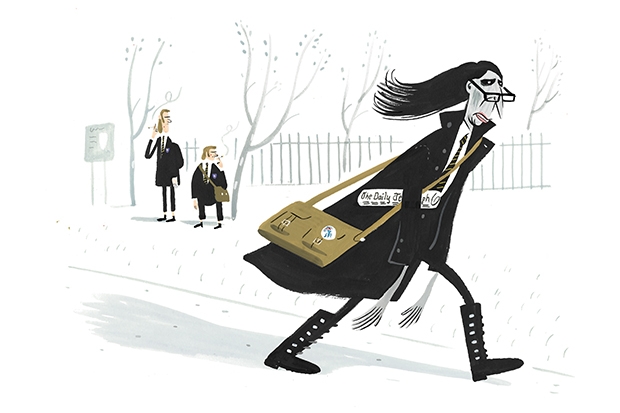If only I’d known. If only I’d foreseen that the teenage classmate who strode through our school gates every morning, rolled-up Daily Telegraph tucked incongruously (and insouciantly) under one arm, dark leather trench-coat flapping rhythmically in sympathy with the long, swaying black crows-wings of shoulder-length hair, square-heeled boots clicking and clacking their way into morning assembly… if I’d somehow intuited, as I say, that this lanky 15-year-old with the questing, beaky nose and rimless glasses, this proto-goth, would one day be Chancellor of the Exchequer…
Well, actually, I wouldn’t have been remotely surprised. I don’t think any of us who knew Philip Hammond back in 1971 at Shenfield School in Essex would’ve been. Political destiny was written all over the guy.
Since Phil emerged as a major player in the high-rolling, high-risk casino world of Westminster politics, I’ve been approached by countless media outlets all wanting to know the same thing.
‘What was he like? Just how right-wing was he back then? Was he Tory Boy? Did you all hate him?’
I know what they want. Many of them are hoping for a clichéd, pastiche-of-a–profile of your typical post-war Tory Boy; the neo-righty that everyone loathed by default.
But Phil wasn’t like that, and more to the point we didn’t see him like that. The general political mood in the early 1970s was nowhere near as polarised as it is today. These were pre-Thatcher times. The word ‘Tory’ did not, back then, invite the almost inevitable suffix ‘scum’.
Of course, most of Phil’s fellow fifth-formers were on the left. We were adolescents, children of the 1960s, pretend revolutionaries. We wore Che Guevara T-shirts and inserted the word ‘proletariat’ into as many sentences as we could manage.
So for Phil Hammond to stroll to school each day carrying the Telegraph — which he would calmly read in assembly and during the lunch break — was so uncool that it was, well… cool. That was Phil. We secretly admired him for his breezy unconcern for what anyone else might think.
Actually — not so secretly. Phil was popular at Shenfield. I don’t remember him having any enemies, although neither do I remember him having a particular clique or band of followers. My mental video diary shows him striding from classroom to classroom alone, arriving and leaving school alone, and sitting alone in lessons. My clearest image of these classes was history. Our O-level syllabus was mostly predicated on 20th-century events and Phil was not a biddable student.
While the rest of us obediently scribbled down the received nostrums about the origins of two world wars and their aftermaths, Phil would argue and challenge our teacher. Not in a hectoring, disputatious way; more in sorrow than in anger. ‘Surely you can’t believe…’ ‘But, sir, no one would think today that…’ ‘I’m truly sorry to hear you say that, sir, because you’re wrong. Just wrong…’
We loved it, even if we didn’t really understand Phil’s arguments. That didn’t matter — it was enough to see our teacher discomfited and thrown off balance. Perhaps that was our small revolution, looking back, and Phil led it.
He also charmed the teacher, a dedicated Guardian reader. Phil often persuaded the man to swap his newspaper for Phil’s copy of the Telegraph and the two of them would cheerfully snipe away at each other about the editorials. The rest of us barely knew what they were talking about. But we were proud of the fact that our classmate was as bright and as well-informed as our teacher.
Going back over what I have just written, I can see this beginning to look like a hagiography. Well, so be it. The fact is, we all liked Phil Hammond. That he was an unabashed Tory just made him a bit stuffy and old-fashioned, but entertainingly so. And as for myself, I’m not remotely politically aligned — so there’s no hidden agenda in this article. I’m just telling you what I remember.
But back to Phil. There was another side to him, about as unlike Tory Phil as you could get.
I’m talking about Disco Phil.
Yup. Our Chancellor-to-be had a nice little line running discos in Essex. He teamed up with the best-looking guy in our year, the improbably named Graham Norton, to run weekend church-hall discos. I’m not privy to their financial arrangements, but Graham — who like myself and Phil is now 60 (which does feel improb-able) says he took roughly a tenner for doing the actual DJ-ing while Phil took… well, let’s just say rather more than that. A clear head for figures, then, even back in the day.
I left Shenfield School at 16 to join the local paper as a cub reporter, so I never knew the sixth-form Phil, or his later incarnations as a university student and then successful entrepreneur/businessman.
But after more than 40 years spent in hard news, live television, and (nowadays) freelancing, one thing I’ve learned for sure, both subjectively and objectively, is this: you’re fundamentally the same person at 60 as you were at 16. You really are.
So who was Philip Hammond at 16? How best to sum him up?
Easy. He was his own person. Looks to me as though he still is.






Comments